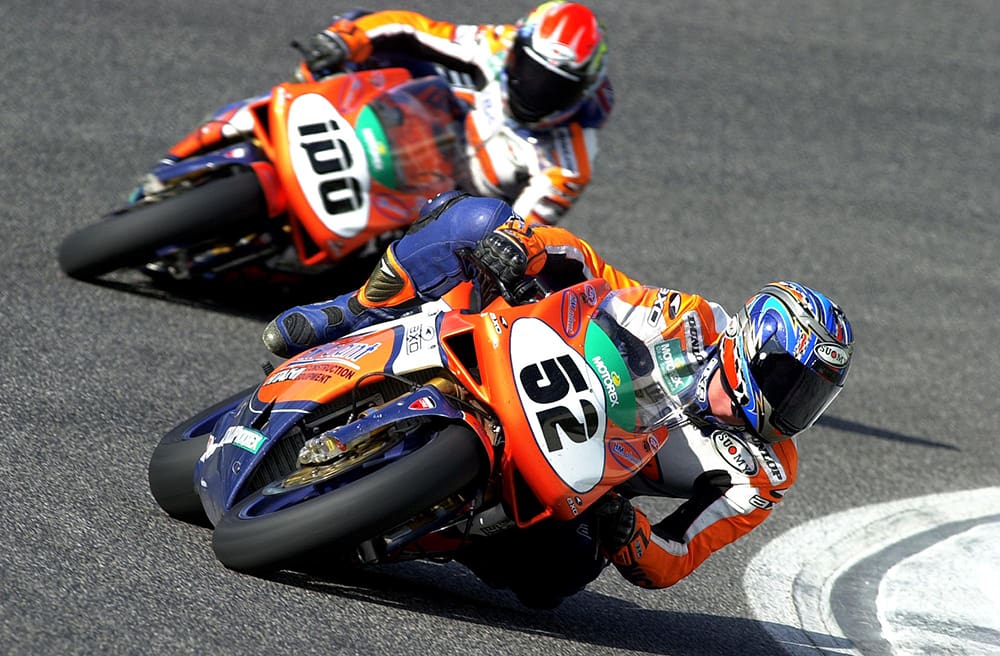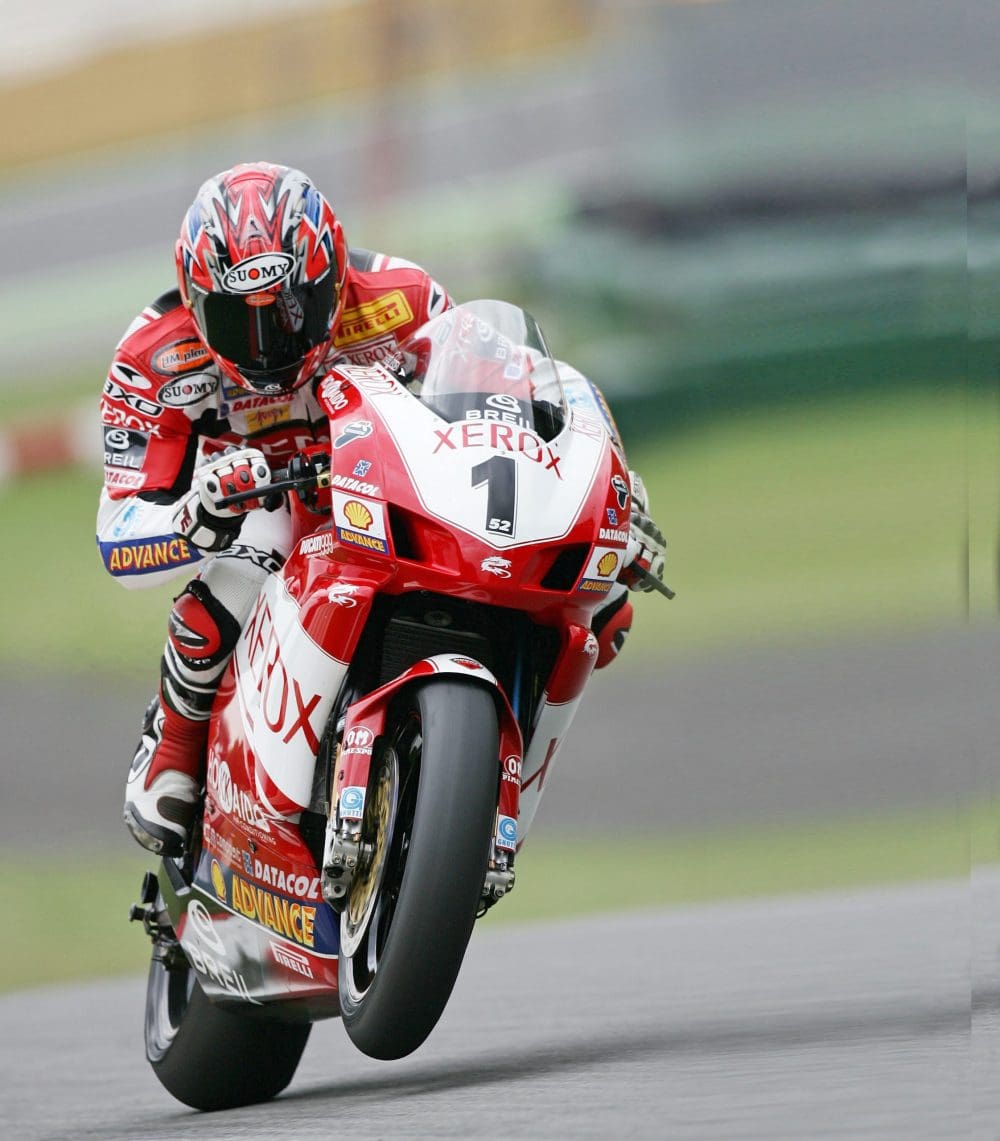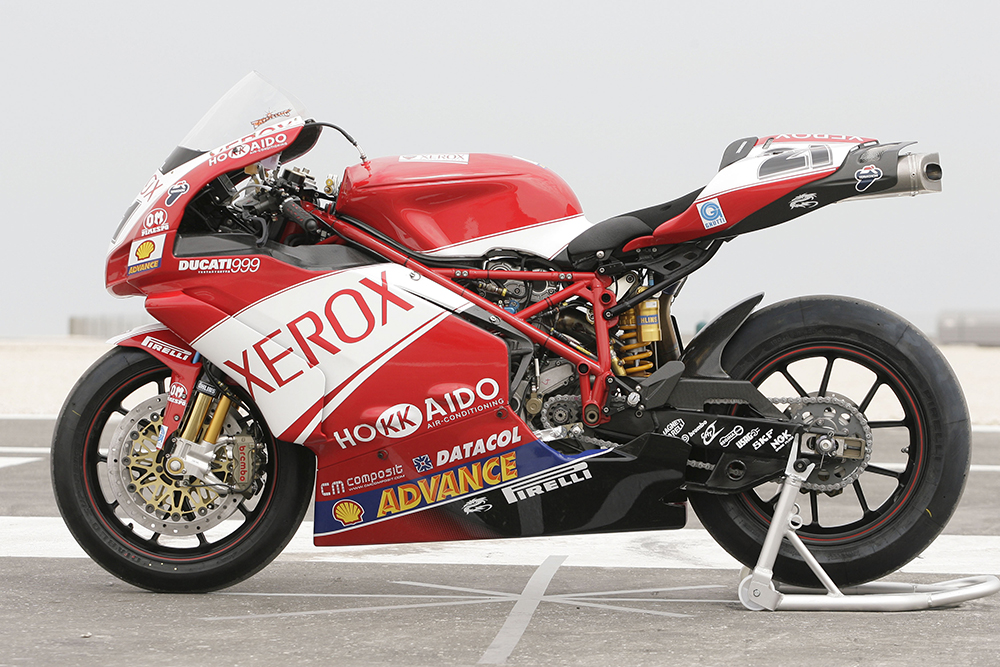The 999 was a winner from the start and has won more races than any other Ducati, which says the bike was easy to get right. But nothing could be further from the truth
The Ducati 999 is the company’s most successful World Superbike weapon – with more wins than the 851, 888, 916, 996, 998, 1098, 1198, 1199 and the 1299 Panigale. Not only that, the bike is the favourite of Ducati legend Troy Bayliss, who won three WSBK titles on the three different Ducatis: the 998, the 999 and the 1098.
“I loved them all – they were all really great bikes in their eras,” says Bayliss, who also won the 1999 BSB title on a 996.
“I think the 999 is a bit of an ugly duckling but I’ve got all my racebikes at home and the 999 is the one, but only just.”
In 2006 Bayliss returned from a three-year stint in MotoGP to win the 999’s third WSBK crown, following in the wheel tracks of Neil Hodgson and James Toseland: who had given the model a perfect start with the 2003 and 2004 WSBK titles. Hodgson gave the 999 a stunning debut in 2003, winning the first 10 races, but it wasn’t as easy as it looked.
“Everyone assumed that the 999 must be a great bike but it wasn’t – it was really weird,” Hodgson says.
“It was nowhere as good as the 998, but I could never say that at the time. What it had going for it was speed, plus I had Michelins which were better than Dunlops at most tracks. That’s why I won the championship: speed and tyres.”
The first 999 – tagged the F03 – certainly had a lot of go: 140kW (189hp) at 12,500rpm, a whopping 11kW (15hp) more than the 998. At 164kg it was also 2.5kg lighter, largely thanks to its single silencer box which weighed half as much as the 998’s prettier twin tail pipes.
“Handling-wise the bike was a bit of a pig,” Hodgson continues.
“When you got to tracks with faster corners the front end never felt right. When I first tried the 999 it was horrible. I remember thinking, oh no, what’ve I done? The issue with the handling never really changed. It was there all season. It seemed to push the front and I never had the confidence I’d had with the old bike.
“If I’d ridden my 998 with a 999 engine and Michelin tyres I’d have been another second-a-lap faster, so it was frustrating. I was lucky that my crew chief Ernesto Marinelli was a genius.”
Ducati tried everything to improve the chassis, including using the removable frame spar that allowed better access to the top end of the rear cylinder as a stiffness tuning tool.

This gave a small difference in torsional stiffness. So on smooth tracks the spar was fitted for better precision and on bumpy tracks the spar was removed for more comfort. Hodgson, however, says he couldn’t tell the difference. Because Ducati was unable to resolve the problems, it was left to Michelin to provide a band aid.
“We did an unbelievable amount of front-tyre testing at Michelin’s test track,” adds Hodgson.
“Eventually we stumbled across something that helped mask the problem, so even if we were at a difficult track we often had a massive grip advantage.”
With a better front tyre and the 999’s brute power, Hodgson sealed the title and then departed for MotoGP.
“When I left I was thinking, phew, I got away with that one,” he says.
Unfortunately Ducati couldn’t rely on Michelin to defend the 999’s first title because in 2004 WSBK became the first world series to switch to a control tyre, with Pirelli supplying rubber that was nothing like the Michelins. That’s why James Toseland was in for a rude awakening when he signed to ride a factory Ducati F04. Like Hodgson, Toseland came from the British GSE team which had run 998s.
“In 2003 the factory Michelins had made the 999 look pretty special, so I was all excited about riding for the factory team, but the bike wasn’t developed for the Pirellis,” Toseland says.
“I remember my first test on the bike was pretty bad. The bike was that bad that Pierfrancesco Chili decided to race his 998 with a 999 engine. Ducati was very, very upset about that, and he led the championship after the first three rounds because the 998 was so much more forgiving on the Pirellis.”
Toseland’s secret was consistency. While he only won four races, he won the title ahead of teammate Regis Laconi who won seven.
“Mid-corner I couldn’t get a good front-end feeling from the bike,” Toseland says.
“It made life a lot more complicated because I didn’t have that same comfortable feeling I’d had on the 998. It took us half a season to find a setting I liked with the Pirellis – and then I had a much stronger second half.

“We played so much with offset and head angle to get the bike set up for the Pirellis. We ended up with 28mm offset and a 24.5° head angle.
“Regis ran less offset because the front felt a bit vague, so he liked to be right on top of the front to get some feeling, but then the bike was unstable. I liked 28mm offset for a bit more length and stability.”
Front-end problems weren’t Toseland’s only concerns. He had arrived in the factory team at the dawn of a whole new era.
“Ducati started developing traction control in 2004 and that was very difficult because the Pirellis made life very difficult for the electronics,” he says.
“They were so good for the first two laps and then so bad after three or four laps. In fact we curbed electronics development because there was so much to do chassis-wise.
“I decided not to run any electronics and we were faster without at that point.”
Toseland took the 2004 title at the final race of the year, bettering Laconi by just nine points. But if he thought that 2005 would be easier, he was wrong, even though the F05 had 144kW (194hp).
Beaten from first to fourth place by a Suzuki GSX-R, Honda Fireblade and Yamaha R1 in 2005, Ducati sacked Toseland and brought back Bayliss, who had been dumped by Ducati’s MotoGP team.
The tough Aussie had an iffy start with the F06 999, but it only took him a day to get it sorted.
“At the end of my first day on the bike we changed the head angle and offset back to where I normally had it and straight away I was faster and after that we hardly touched a thing,” Bayliss says.
“It felt like my bike, like a 998, but a better version. It was just a lovely bike.”
Bayliss used pretty much the same geometry all the way from his first full WSBK season in 2001 to the end of his career: either 26 or 27mm offset and 23.5° head angle.

“The way I had the bike, it was heavy to ride – you had to really wrestle it,” he adds.
“It wasn’t really direct, like something (Noriyuki) Haga would ride. He used to point the bike on its nose. A lot of the guys on Japanese bikes were backing it into corners, but you didn’t see me do that very often because I had the bike set up to be stable – well, I thought it looked stable!
“I also used a digressive shock link while a lot of the other Ducati guys used a flat link.
“I liked it a bit softer, so you could ride it lower in the back, but you had to really look after the rear tyre over race distance.”
Bayliss dominated in 2006 and was favourite to retain his title the following year. But the Japanese fours were still taking major leaps forward and the F07 was largely unchanged from the F06. Team boss Davide Tardozzi called the bike the F06-and-a-half.
“I think we got 250 more revs out of it, that was about it,” Bayliss says. “The biggest thing for 2007 was that the Japanese bikes were getting better with their electronics and they were definitely a bit faster on top end, but there were tracks where I could have really good races with them.
“Our biggest improvement for 2007 was the traction control. In 2006 you could hear the system cutting in, like a misfire, but by 2007 it was much more refined and you couldn’t really hear it working. My biggest thing, apart from working on the suspension, was the first opening of the throttle.
“I was always wanting to smooth out that first touch of the throttle when you’re leant over. My electronics technician Alessandra Balducci was brilliant at doing that.”
And yet despite the anti-spin technology the decisive moment of the 2007 title battle came at Donington – where Bayliss had a huge crash at Coppice corner.
“The back came around on me mid-turn, then it was a bit of a death wobble and a highsidy thing.”
A mangled finger and an injured testicle were enough to undo his season. Halfway through 2007 Bayliss got his first go on the 1098, preparing the bike for 2008. Bayliss had never been a great fan of rider aids, but the 1098 changed all that: “The 1098 definitely needed traction control,” he says.
“On the 999, even without traction control, it had beautiful power, which is why I did my fastest-ever lap at Phillip Island on a 999. The 1098 had a lot more midrange, so it wanted to wheel-stand everywhere.”

Ducati 999F06, Qatar WSBK, 2006